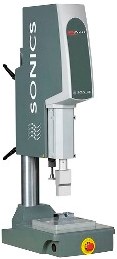 The short answer is, it depends on the application. For instance, typical ultrasonic assembly applications require an extremely slow and precise joining velocity, making them ideally suited for a stepper motor system, where the motor moves with absolute mathematical precision.
The short answer is, it depends on the application. For instance, typical ultrasonic assembly applications require an extremely slow and precise joining velocity, making them ideally suited for a stepper motor system, where the motor moves with absolute mathematical precision.
More torque is available from a stepper motor in these ultrasonic applications that require slow, precise movement, enabling higher weld forces if needed. A stepper’s smooth acceleration up to the programmed weld velocity eliminates the high force spikes at melt initiation that often occur with a servo motor. Rapid downward stroke also minimizes cycle times.
A servo motor, on the other hand, is ideally suited for applications requiring high speed movement of heavy loads. An application where the actuator is required to adapt quickly and change speeds, often resulting in more vigorous acceleration and deceleration rates, lends itself towards servo control.
Understanding a little more about the characteristics of each type of motor may also shed some light on which motor best suits your application. A stepper motor is defined as a device whose normal shaft motion consists of rotational movements of essentially uniform magnitude when driven from a sequentially switched DC power supply.
One digital pulse to a step motor drive or translator causes the motor to increment one precise degree of motion. As the digital pulses increase in frequency, the step movement changes into continuous rotation.
By definition, a servo motor is a motor that uses feedback in its operation. Servo motors are generally an assembly of four things: a DC motor, a gearing set, a control circuit and a position-sensor (usually an encoder). The characteristic of correcting position error on a continuous basis is really what accurately defines a servo motor and a servo system’s velocity is constantly fluctuating based on the feedback system’s error correction.
If this sounds a little confusing, well, that’s not totally surprising as the lines between stepper and server motors have become increasingly blurred with continued engineering advancements. For instance, some stepper motors can incorporate feedback device algorithms which effectively transform the stepper motor into a servo.
Likewise, servo motors sometimes utilize stepper motors to give all the functionality of a servo at a greatly reduced cost.
So, if what you’ve read here so far has not yet definitively identified the best motor for your application, may we recommend what we always view as the first best step in any welding application – consult with the experts: the companies who manufacture the welding equipment. They are best suited to troubleshoot your application and identify the best machine and materials for the job.
To speak with one of our applications experts, call us at 1.800.745.1105, or contact us online at www.sonics.com
Categories:



Post a comment